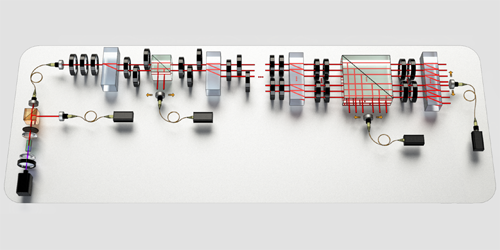An Optical System Defies Conventional Band Theory
Quantum systems that obey parity-time symmetry exhibit “exceptional points” within their parameter space. In quantum optical systems, these are points where a light beam’s energy gains and losses are perfectly balanced, leading to rich critical phenomena, such as extreme sensitivity to external parameters. Parity-time symmetry can be engineered into systems via designs that ensure a balance of inward and outward energy flows (see Viewpoint: PT Symmetry Goes Quantum). Now, Lei Xiao, at Beijing Computational Science Research Center, and colleagues demonstrate a new way to produce both parity-time symmetry and exceptional points in a quantum-optical circuit. Their study could allow tools for tuning exotic behavior in photonic, phononic, and cold-atom systems [1].
Researchers usually achieve the energy input-output balance necessary to generate parity-time symmetry using systems with spatially periodic structures. The emergence of exceptional points in such systems is predicted using Bloch band theory. In their experiment, Xiao and his colleagues observed the presence of parity-time symmetry and exceptional points by measuring how photons interact with themselves as they propagate through a series of optical elements. Although this system has a periodic spatial structure in its bulk, it has an open boundary condition, meaning its properties cannot be described by conventional Bloch band theory.
The researchers concluded that parity-time symmetry arose in their experiment as a result of the “skin effect,” meaning that wave functions are squeezed toward a system’s boundary. Because it skews the bulk wave functions, the skin effect can only be described by an unconventional “non-Bloch band theory.” Designing artificial materials to harness this mechanism could lead to quantum devices with high-resolution sensing capabilities.
–Rachel Berkowitz
Rachel Berkowitz is a Corresponding Editor for Physics Magazine based in Vancouver, Canada.
References
- L. Xiao et al., “Observation of non-Bloch parity-time symmetry and exceptional points,” Phys. Rev. Lett. 126, 230402 (2021).




